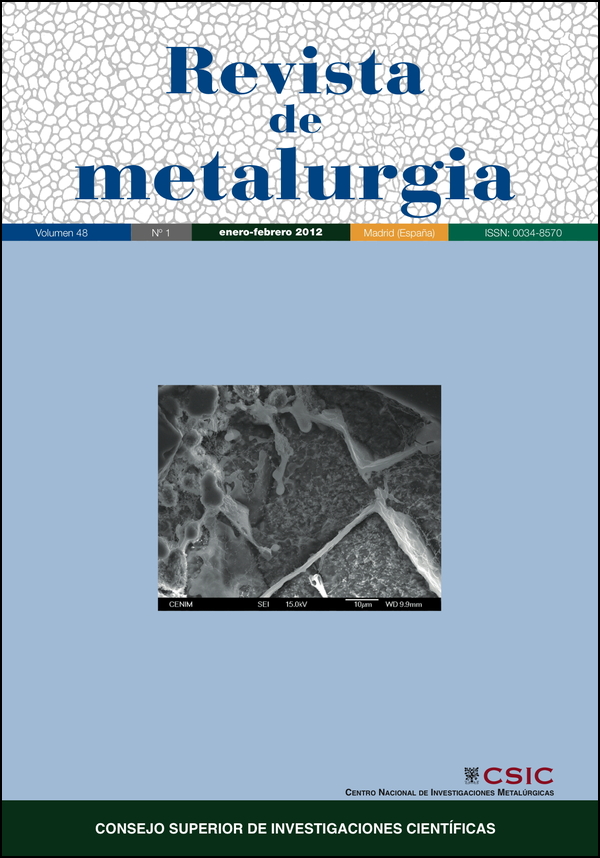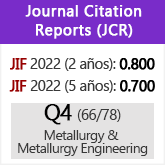Proceso de microencapsulación de mercurio líquido mediante tecnología de estabilización/solidificación con azufre polimérico. Parte I: Caracterización de materiales
DOI:
https://doi.org/10.3989/revmetalm.1133Palabras clave:
Mercurio, Metacinabrio, Estabilización/solidificación con azufre polimérico, Microencapsulación, Lixiviación, Emisiones de mercurioResumen
Resumen Las Directivas Europeas consideran al mercurio una sustancia de peligrosidad prioritaria debido a sus efectos adversos sobre la salud humana y sobre el medio ambiente. En respuesta a estas preocupaciones ambientales, y dentro del Programa Europeo LIFE, se ha desarrollado un proceso de microencapsulación como una opción al almacenamiento a largo plazo del mercurio. Con este proceso se obtiene un material estable, tipo concreto, de matriz de azufre que permite la inmovilización del mercurio. El producto final, en forma de un bloque sólido, contiene hasta un 30 % de Hg, presenta excelentes propiedades mecánicas (resistencia a la compresión 53-61 MPa, y a la flexión 7-10 MPa), baja porosidad (0,57 % PHe), muy bajo volumen total de poro (0,63 x 10-2 cm3 g-1) y una permeabilidad extremadamente baja (coeficiente de absorción de agua por capilaridad 0,07 g cm-2). Las características de toxicidad determinadas mediante los ensayos de lixiviación indican una concentración de mercurio en los lixiviados muy por debajo de los límites (< 0,2 mg L-1) establecidos por la Normativa de Restricción de Disposición de Residuos en el Suelo de EE.UU (US EPA Land Disposal Restrictions, LDRs). También se han determinado las emisiones de vapor de mercurio en los productos finales obteniéndose valores más bajos que en muestras de cinabrio y metacinabrio.
Descargas
Citas
[1] UNEP, Draft technical guidelines on the environmentally sound management of mercury wastes, 4th Draft, April, 2009. http://www.basel.int/techmatters/mercury/guidelines/040409.doc
[2] Directive 2000/60/EC of the European Parliament and of the Council of 23 October 2000 establishing a framework for Community action in the field of water policy, Official Journal. L 327, (22/12/2000), 0001-0073.
[3] Regulation (EC) No 1102/2008 of the European Parliament and of the Council of 22 October 2008 on the banning of exports of metallic mercury and certain mercury compounds and mixtures and the safe storage of metallic mercury, Official Journal of the European Union. L 304 (14/11/2008), pp. 75-79.
[4] T. Brasser. Mercury storage in Europe and Germany Regulations and General Conditions on “Mercury Storage Project Inception Workshop” Bangkok, Thailand, March 4-5. 2009. http://www.chem.unep.ch/mercury/storage/GRS-Germany%20T%20Brasser.pdf
[5] European Commission, Brussels, Requirements for facilities and acceptance criteria for the disposal of metallic mercury, Bipro, Final Report, 16, April, 2010.
[6] M. Svensson, B. Allard and A. Düker, Sci. Total Environ. 368 (2006) 418-423. http://dx.doi.org/10.1016/j.scitotenv.2005.09.040
[7] F.A. López, A. López-Delgado, I. Padilla, H. Tayibi and F.J. Alguacil, Sci.Total Environ. 408 (2010) 4341-4345. http://dx.doi.org/10.1016/j.scitotenv.2010.07.008 PMid:20673963
[8] e-CFR. 40 Protection of Environment. I Environmental Protection Agency. I Solid Wastes. Part 268 Land Disposal Restrictions, subpart D 268.42 Treatment standards expressed as specified technologies. http://cfr.vlex.com/vid/268-expressed-specified-technologies-19820104
[9] P. Randall and S. Chattopadhyay, J. Hazard. Mater. B114 (2004) 211-223. http://dx.doi.org/10.1016/j.jhazmat.2004.08.010 PMid:15511593
[10] R. Malviya and R. Chaudhary, J. Hazard. Mater. B137 (2006) 267-276. http://dx.doi.org/10.1016/j.jhazmat.2006.01.065 PMid:16530943
[11] J.M. Zhuang, T. Lo, T. Walsh and T. Lam, J. Hazard. Mater. B113 (2004) 157-164. http://dx.doi.org/10.1016/j.jhazmat.2004.06.003 PMid:15363526
[12] X.Y. Zhang, Q.C. Wang, S.Q. Zhang, X.J. Sun and Z.S. Shang, J. Hazard. Mater. 168 (2009) 1575-1589. http://dx.doi.org/10.1016/j.jhazmat.2009.03.050 PMid:19376646
[13] H. Vroom, Sulfur cements, process for making same and sulfur concretes made therefrom. Patent US 4058500 (1977).
[14] STARTcreteTM Technologies Inc. laboratory procedure for producing STARcretesTM test specimens. Tehnical Report, 2000.
[15] M.M. Jonhson, M. Simfukwe, G.P. Nowack and D.H. Kubiced, Patent US 5360632 (1994).
[16] P.D. Kalb, D. Melamed, B.R. Patel and M. Fuhrmann, Patent US 6399849 (2002).
[17] M. Fuhrmann, D. Relamed, P.D. Kalb, J.W. Adams and L.W. Milina. Waste Manage. 22 (2002) 327-333. http://dx.doi.org/10.1016/S0956-053X(01)00057-5
[18] F.A. López, A. López-Delgado, F.J. Alguacil and M. Alonso, Spanish Patent P200930672 (2009).
[19] A. López-Delgado, F.A. López, C. Pérez, F.J. Alguacil, A. Conde, M. Ramos and P. Higueras, 9th International Conference on Mercury as a Global Pollutant, Ghuizhou, China, 2009, pp.
[20] Real Decreto 2661/1998, de 11 de diciembre, por el que se aprueba la Instrucción Española del Hormigón Estructural (EHE), BOE num.11 (13/01/1999) 1525-1526.
[21] UNE EN 196-1:2005. Métodos de ensayo de cementos. Parte 1: Determinación de resistencias mecánicas, 2005.
[22] TCLP, EPA Method 1311. Toxicity Characteristic Leaching procedure, http://www.epa.gov/osw/hazard/testmethods/sw846/pdfs/1311.pdf
[23] EPA Method 7474. Mercury in sediment and tissues samples by atomic fluorescence spectrometry, http://www.epa.gov/osw/hazard/testmethods/sw846/pdfs/7474.pdf
[24] G.R. Darnell. Stabilization and Solidification of Hazardous, Radioactive, and Mixed Wastes, T. Michael Gillian and Carlton C. Willes (editors), vol. 3, American Society for Testing and Materials, West Conshohocken, PA, 1996, pp. 272-283.
[25] P.D. Kalb, J.W. Adams, M.L. Meyer and H.H. Burns, Stabilization and Solidification of Hazardous, Radioactive, and Mixed Wastes, T. Michael Gillian and Carlton C. Willes (editors), vol. 3, West Conshohocken, PA, 1996, pp. 327-340.
[26] US EPA Land Disposal Restrictions Regulations for Mercury-Containing Non-wastewater. http://www.epa.gov/osw/hazard/wastetypes/universal/lamps/faqs.htm
[27] Mercury Laws and Regulations. Land Disposal Restrictions Regulations for Mercury- Containing Waste. http://www.epa.gov/mercury/regs.htm#wastes
Descargas
Publicado
Cómo citar
Número
Sección
Licencia
Derechos de autor 2012 Consejo Superior de Investigaciones Científicas (CSIC)

Esta obra está bajo una licencia internacional Creative Commons Atribución 4.0.
© CSIC. Los originales publicados en las ediciones impresa y electrónica de esta Revista son propiedad del Consejo Superior de Investigaciones Científicas, siendo necesario citar la procedencia en cualquier reproducción parcial o total.Salvo indicación contraria, todos los contenidos de la edición electrónica se distribuyen bajo una licencia de uso y distribución “Creative Commons Reconocimiento 4.0 Internacional ” (CC BY 4.0). Puede consultar desde aquí la versión informativa y el texto legal de la licencia. Esta circunstancia ha de hacerse constar expresamente de esta forma cuando sea necesario.
No se autoriza el depósito en repositorios, páginas web personales o similares de cualquier otra versión distinta a la publicada por el editor.


















